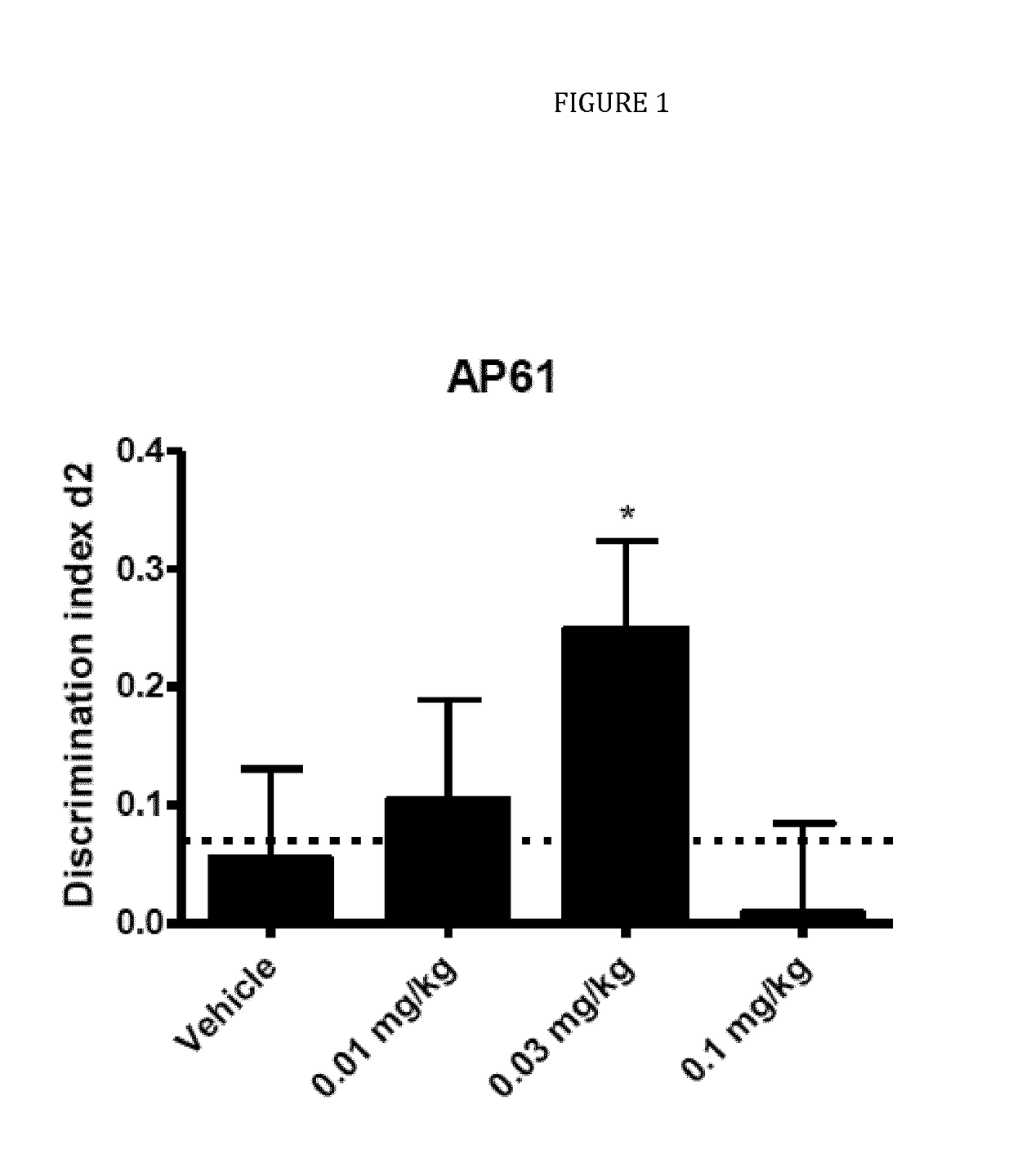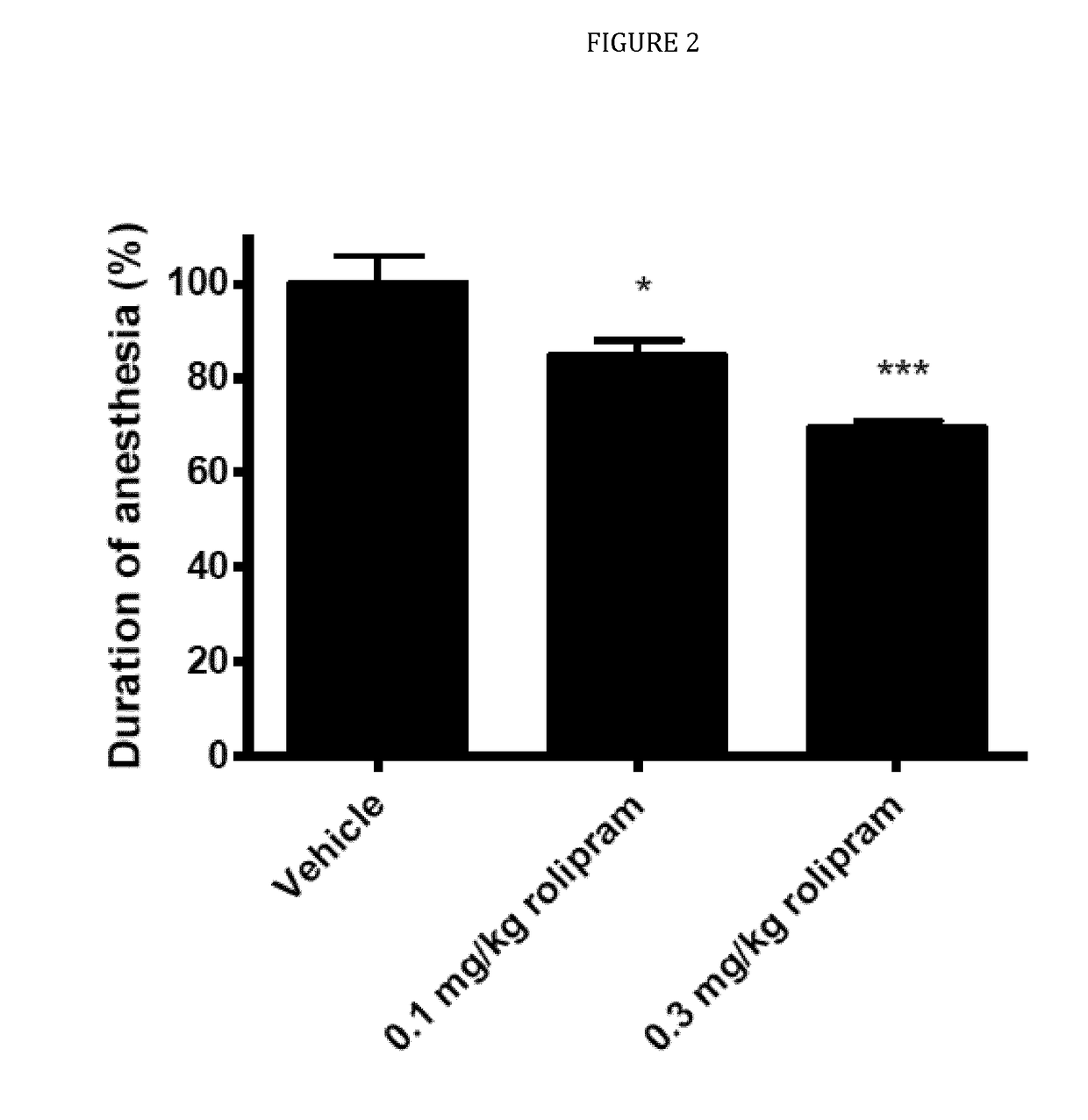Treatment of cognitive disorders
a cognitive disorder and treatment technology, applied in the field of cognitive disorders, can solve the problems of affecting the autonomy and quality of life of individuals, significant impairment of social and/or occupational functioning, and deficits in attention, so as to increase the potential therapeutic window and induce gastrointestinal toxicity
- Summary
- Abstract
- Description
- Claims
- Application Information
AI Technical Summary
Benefits of technology
Problems solved by technology
Method used
Image
Examples
example 1
ts of AP-61 in Wistar Rats in a Test of Natural Forgetting in the Object Recognition Task (ORT)
[0091]In example 1, the compound AP-61 a 7-(4-tert butyl-cyclohexyl)-imidazotriazione (a compound of the formula II) was tested in the ORT in 3-4 month old male Wistar rats using a 24-h interval between the trials to induce natural forgetting.
[0092]One group of twenty four 3-4 month old male Wistar rats (Charles River, Sulzfeld, Germany) were used (average body weight at the beginning of the study: 365 g). All animals were housed individually in standard green line Tecniplast IVC cages on sawdust bedding. The animals were housed on a reversed 12 / 12-h light / dark cycle (lights on from 19:00 h to 07:00 h) and had free access to food and water. The rats were housed and tested in the same room. A radio, playing softly, provided background noise in the room. All testing was performed between 09:00 h and 18:00 h.
[0093]AP-61 was dissolved in 0.5% methylcellulose (MC) and 2% Tween 80. The solutions...
example 2
ts of AP-61 and Rolipram in the Xylazine / Ketamine-Induced Anesthesia Test in Male Wistar Rats
[0104]Development of PDE4-Is as therapeutic drugs has always been hampered by the dose-limiting emetic side effects (nausea and vomiting) in humans of the classic PDE4-I rolipram, which has been developed as a possible anti-depressant in the eighties of the previous century (Prickaerts, 2010). Currently, PDE4-Is are being developed which show a strong reduction in emetic side effects. In the present study, the possible emetic properties of AP-61, were investigated and compared with the emetic properties of the classic PDE4-I rolipram.
[0105]The mechanism of the emetic response associated with PDE4-Is is thought to be a consequence of the inhibition of PDE4 in non-target tissues. It is believed that PDE4-Is produce a pharmacological response analogous to that of presynaptic α2-adrenoreceptor inhibition by elevating intracellular levels of cAMP in noradrenergic neurons. Therefore, by removing a...
example 3
t of Co-Administration of Sub-Efficacious Doses of AP61 (0.01 mg / kg) and Donepezil (0.1 mg / kg) in Wistar Rats in a Test of Natural Forgetting in the ORT
[0117]In the third example a combination of sub-efficacious doses of donepezil (0.1 mg / kg) and AP-61 (0.01 mg / kg) were investigated. AP61 was dissolved in 0.5% methylcellulose (MC) and 2% Tween 80. The solutions were prepared daily. Doses of 0.01, 0.03 and 0.1 mg / kg of AP61 or vehicle were administered p.o. (injection volume was 2 ml / kg), 4 min after T1. Considering the long plasma Tmax of AP61 (5 h), it was chosen to administer 4 min after T1 to obtain highest plasma concentrations during the late consolidation phase. Donepezil was dissolved in saline and also prepared daily. A dose of 0.1 mg / kg was administered p.o. (injection volume 2 ml / kg), 30 min before T1 to mainly target the memory acquisition process in the ORT.
[0118]The results of exploration times in T1 and T2 and the discrimination indexes of the different conditions are ...
PUM
| Property | Measurement | Unit |
|---|---|---|
| Concentration | aaaaa | aaaaa |
| Stereoisomer | aaaaa | aaaaa |
Abstract
Description
Claims
Application Information
 Login to View More
Login to View More - R&D
- Intellectual Property
- Life Sciences
- Materials
- Tech Scout
- Unparalleled Data Quality
- Higher Quality Content
- 60% Fewer Hallucinations
Browse by: Latest US Patents, China's latest patents, Technical Efficacy Thesaurus, Application Domain, Technology Topic, Popular Technical Reports.
© 2025 PatSnap. All rights reserved.Legal|Privacy policy|Modern Slavery Act Transparency Statement|Sitemap|About US| Contact US: help@patsnap.com



